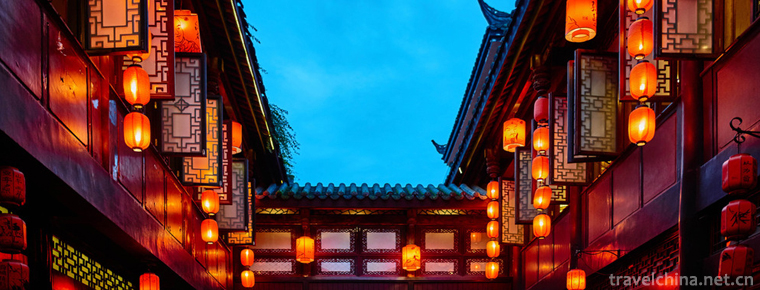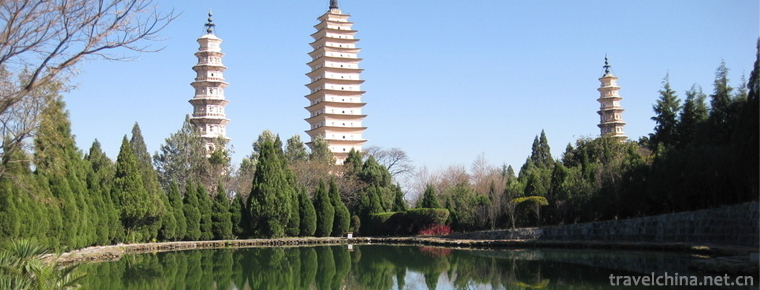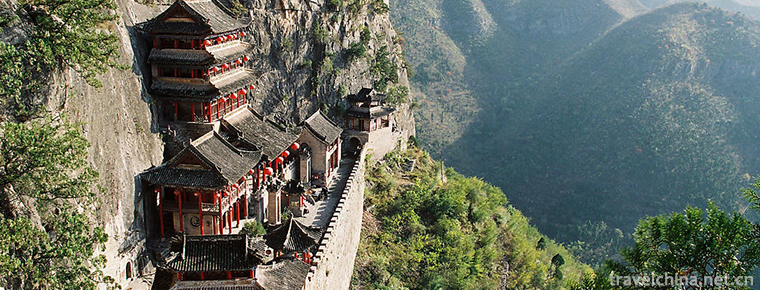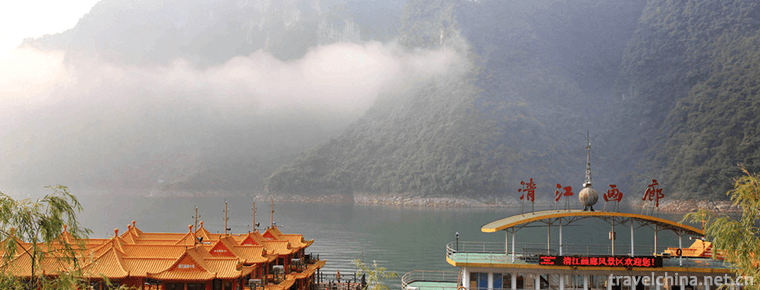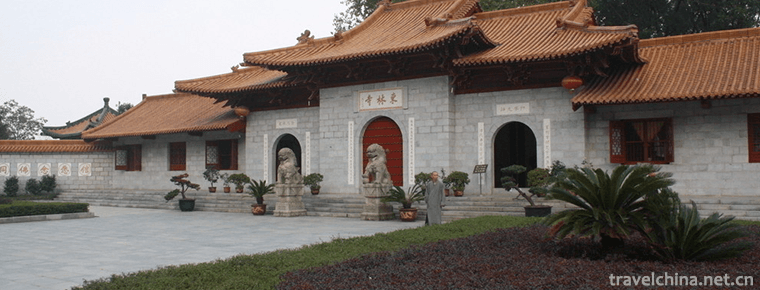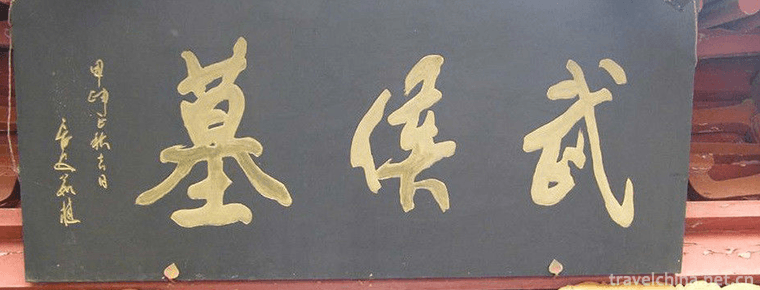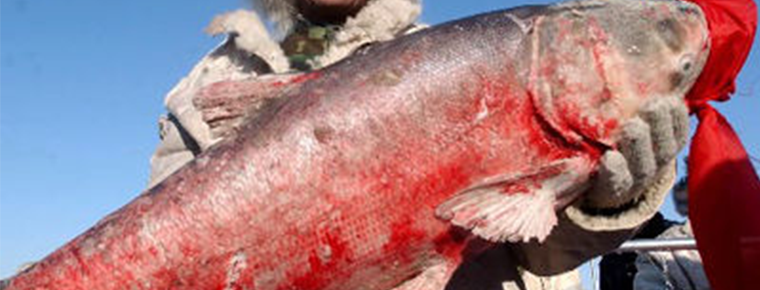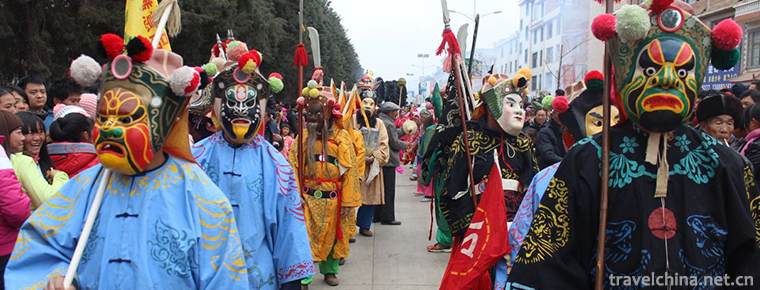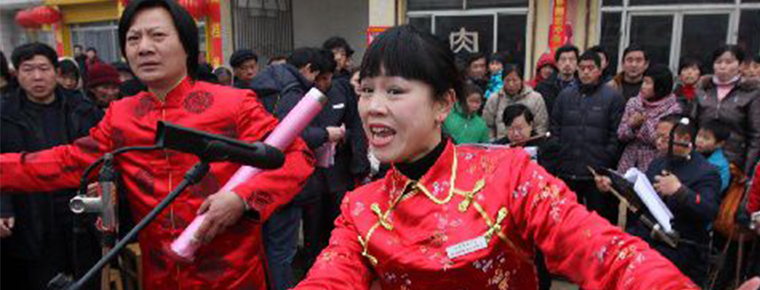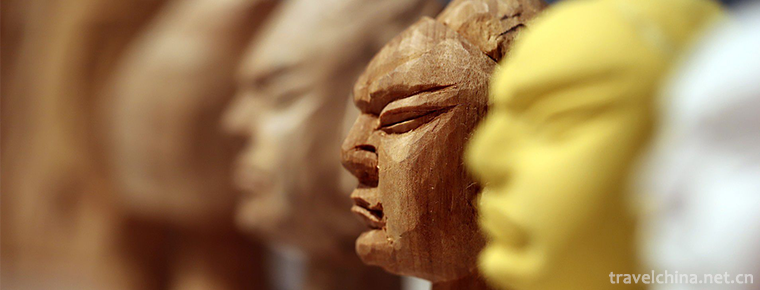Hongjundu Xiwudang Mountain Scenic Area
Hongjundu Xiwudang Mountain Scenic Area
Hongjundu Xiwudang Mountain Scenic Area is the starting point of the Long March of the Four Red Armies, the memorial site of the Campaign of Strong Crossing Jialingjiang River, the national patriotic education demonstration base, the 100 classic red tourism scenic spots, the national AAAA-level tourism scenic area, and the party spirit education base of Cangxi County Party members. It can receive 900,000 tourists every year. From August 12 to 13, 2015, the National Red Tourism Torch Relay - Cangxi Station Fire Ceremony was solemnly held in Hongjundu Xiwudang Mountain Scenic Spot, which became one of the six fire-collecting points in China and the only fire-collecting point in Sichuan.
Hongjundu West Wudang Mountain Scenic Area is located in the important nodes of Sichuan-Shaanxi-Chongqing Red Tourism Line, Northeast Sichuan Red Tourism Line, North Sichuan Tourism Ring Line, Jialing River Water Eco-cultural Tourism Line and Three Kingdoms Cultural Tourism Line. It is 18 kilometers away from the national historical and cultural city, Langzhong, an excellent tourist city in China. It is close to Xiongguan, Xiongguan, the Queen's hometown, Red Bazhong, Zhude's hometown, Xiaoping's former residence and so on. Life Home Tangjiahe and other national key tourist attractions are a comprehensive tourist area with the theme of "Red Land, Green Landscape and Pear Hometown", which integrates red tourism, green tourism, Pear Hometown folklore and Taoist culture tourism.
geographical environment
Cangxi Hongjundu Xiwudang Mountain Scenic Area is located in the east of Cangxi County, along the Jialing River and on the 212 line of National Highway. It is 1 kilometer away from Cangxi County and 18 kilometers away from Langzhong Ancient City. Located in Jialing River Basin Eco-cultural Tourist Area and Three Kingdoms Cultural Tourist Area, it is connected with Sichuan-Shaanxi Red Tourist Line, Long March Road Red Tourist Line, Three Kingdoms Cultural Tourist Line and Jialing River Basin Eco-cultural Tourist Line. It is close to Langzhong Ancient City, Jianmen Pass, Huangze Temple, Zhude's hometown, Deng Xiaoping's former residence, Tang Guohe and other national key tourist attractions.
The scenic spot covers an area of 3.5 square kilometers and consists of three parts: the Red Army Cultural Tourism Area, the Taoist Cultural Tourism Area of West Wudang Mountain and the Eco-leisure Tourism Area. The scenic spot has 8 three-star farmhouse entertainment, 60 residential reception points, 5 local specialty operators, 3 stone and wood carving operators, 5 convenience service stores and 6 children's amusement facilities operators.
Main attractions
The Red Army Crossing Red Cultural Tourist Area has a bronze statue of the Red Army Crossing logo, a landmark building for collecting the torch of the National Long March Spiritual Red Tourism Torch Relay, a memorial hall for the Red Army Crossing, a memorial forest, a Red Army Street, a river crossing command post, Wang Duhe, a hall of meritorious service and a martyr's era. Monuments, General's Mausoleum, Monument to the Campaign of Qiangdu Jialing River and other important tourist attractions. Wudang Mountain Tourist Area has built the West Wudang of China. It has important tourist attractions such as Zhenwu Palace, Cihang Palace, Nantianmen, Wenzhonglou, Yangtianlou and so on. It is an important place for Taoist cultural activities.
Memorial Hall of the Starting Place of the Long March of the Fourth Front Red Army
The Memorial Hall covers an area of 2500 square meters and consists of five halls. Theme pavilions are the Preface Hall, the Eve of the Long March, Jialing in fierce battle, the Long March of waving divisions, the dedication of the Soviet Area, and the elegant demeanor of generals. The subsidiary hall has VIP lounge and multi-function hall. The multi-function hall can accommodate 100 people. It can hold small meetings and perform stereo effect projection. There are more than 3600 precious revolutionary relics of the Red Army period on display in the museum. There are 962 revolutionary relics of the Workers'and Peasants' Red Army on the first and second floors of the memorial hall. Among them, 792 are at the level of collection (670 third-class cloth coins, 60 second-class cloth coins, 20 third-class knives, 19 third-class red cherry guns, 23 third-class grenades); 1015 are carved stone slogans, showing 256 different contents in an all-round way; Fifty-five Memorial relics (23 briefcases, 21 cloth bags and 11 ship models) of the military period were most influential in the "Red Army Seals" (now displayed in the Museum of the Chinese Revolution) and "Qian Yi" (first-class cultural relics of the state). The Memorial Hall of the starting place of the Long March of the Red Fourth Army, with precious pictures and materials as its carrier, comprehensively reflects the process of the Red Fourth Army's establishment of the Sichuan-Shaanxi base area, its forceful crossing of the Jialing River and its waving of the division's Long March. It reproduces the vivid history and heroic feats of the Red Army's victory in the Long March, publicizes and carries forward the great spirit of the Long March, encourages and mobilizes the masses of cadres to strive for Strive hard.
Merit Hall
In the three years since the Fourth Front Army was transferred to Cangxi, the broad masses of the people took part in the Red Army enthusiastically. At that time, there were 280,000 people in the whole county, of whom 30,000 participated. About 100,000 women and children joined in voluntary work. At the Third Soviet Congress in Sichuan and Shaanxi, Cangxi was rated as a model county in Sichuan and Shaanxi Soviet Area. Inside the Meritorious Hall of the Red Army Scenic Area, a large monument to the Red Army martyrs is inscribed with a list of the Red Army martyrs in black and white. The names of the martyrs are arranged on both sides of the stone wall according to the towns under the jurisdiction of their birthplaces. Throughout the Soviet period, Cangxi was ablaze with fires, rivers and mountains. The fire of war burned it into scorched earth. The footprints of the Red Army were all over the county. The blood of the martyrs stained Cangshan River red. More than 25,000 people gave their precious lives. Among them, more than 6,000 martyrs could be traced, which established immortal merits for national independence and the liberation of New China.
Red Army Street
In preparation for the battle of crossing the Yangtze River, the Red Army secretly stationed at Wang Duchang, more than 20 kilometers away from Tashan Bay, and built a "Red Army Street" in the stationed area. While building ships, the Red Army conducted river crossing training. The Red Army carries forward the revolutionary spirit of hardship, simplicity and self-reliance, laying straw shoes, weaving hats, making iron boats, and self-sufficiency, which provides material guarantee for the Red Army's successful forcible crossing of the Jialing River. The Red Army Street in the Red Army Crossing Scenic Area was rebuilt in accordance with the copy of the "Red Army Street" in that year. "Red Army Street" covers an area of more than 13,000 square meters. Its main buildings include magnificent gates, winding corridors, unique exhibition hall of folk culture in northern Sichuan, Tanjia Courtyard, Honggetai and experience area of folk culture in northern Sichuan.
Crossing River Command
The headquarters of crossing the Yangtze River is also called "the old site of the headquarters of the Red Fourth Front Army forcibly crossing the Jialingjiang River", which was called Tanjiayuan at that time. The courtyard is sitting in the north and facing the south. It is a three-in-one, arch-piercing and bucket-piercing traditional residence in northern Sichuan. The central room of the main room was Xu Qian's humble residence and office. It is from here that correct instructions are issued to command tens of thousands of Red Army generals to fight bravely, and ultimately the strategic goal of "forcing over the Jialing River to meet the Central Committee of the Party" has been achieved.
West Wudang Mountain Forest Park
Cangxi is a famous Taoist town. Zhang Daoling, the founder of Taoism in the Eastern Han Dynasty, is a holy place for Taoism to understand, preach, try and practise alchemy and promote truth. Xiwudang Mountain, with its back to Yuntai View and facing the Jialing River, has beautiful scenery and honest literary style, which just constitutes the wonderful scene of "harmony between man and nature". "Taoism follows nature". Human beings originate from nature and are united with nature. There is a relationship of communication and melting between them. "Nature should be followed and nature should be followed". Become a common adherence.
Historical culture
Red Army crossing
In the spring of 1933, the Fourth Front Army of the Chinese Workers'and Peasants' Red Army was ordered to cross Jiangxi to cooperate with the Central Red Army in its northward anti-Japanese campaign. The warlord Tian Songyao gathered forces of 53 regiments and defended them closely along the 200-kilometer River defense line in an attempt to block our westward March by relying on the Jialing River ravine and wait for an opportunity to besiege the four-sided army. In order to smash the enemy's conspiracy and carry out the central strategic policy of "crossing Jiangxi and going north to resist Japan", the Red Army forced the crossing of Jialing River with Tazi Mountain as its main ferry and launched a fierce attack on the enemy. As the army marched westward, it broke down like a bamboo shoot, and the river defense, which was poorly managed, collapsed overnight. The Red Army moved northward and embarked on a new journey.
After the founding of New China, in memory of the heroic achievements of the Red Army soldiers and in memory of the Red Army's victory in crossing the Yangtze River, Cangxi people named the ferry under Tazi Mountain "Red Army Ferry".
Red Army Sculpture Female Soldier Prototype: Stone Grinding Jade
The original figure of the female Red Army soldier in the sculpture is Shimoyu. She is a smart, lively and strong girl. From childhood, he and his adoptive father made a living by fishing, knew water well and practiced a whole body of martial arts. They had an indissoluble bond with the Red Army in the revolutionary war.
On March 28, 1935, Shimoyu and his adoptive father and brother secretly discovered the enemy's ship and took it back. The adoptive father took the helm and carried the soldiers across the river. On the way, the foster father unfortunately shot and died, and the boat whirled. At this critical juncture, the strong stone grinding jade endured grief, quickly took over the oars, and continued to cover the soldiers crossing the river. Suddenly, she felt a shock at the hem of her military uniform. She was hit in the abdomen by shrapnel and her intestines collapsed. Regardless of her wounds, she clenched her teeth, pushed her intestines into her abdominal cavity, strapped the wound with a belt, withstood the pain, and put the last effort into rowing the boat to the other side. At the last moment of her life, she tried to wave to the soldiers in the fierce battle with a strong smile.
The battle of forcibly crossing the Jialing River was won, but Shimoyu was sacrificed, and blood stained the galloping and roaring waters of the Jialing River. The spirit of stone polishing inspires our generations of Chinese sons and daughters to love their jobs, work hard, put aside their selfish desires and take the overall situation into consideration, and devote their light and enthusiasm to the great cause of national rejuvenation.
Magic slogans
After the opening of the Red Army Crossing Scenic Area to the outside world, 65 stone inscriptions of the Red Army were collected from various villages and towns in Cangxi. There are many wonderful stories about the production of these Red Army slogans, among which the most wonderful one is called "Magic Slogans". The hero of the story, Wang Wenhuan, is in his thirties. He is not tall and weak. He often goes deep into towns and villages in enemy-controlled areas and posts his Red Army propaganda slogans, even at enemy checkpoints. One day, Wang Wenhuan disguised himself as a hawker and went to the county town to put up a sign. Because the bogus guard Li Tuozi informed him, Wang Wenhuan was caught in the bogus police station. During the following seven days and seven nights, the enemy forced him to confess to the underground party organization with cruel penalties such as "duck running water, sitting on a tiger stool". Wang Wenhuan did not give in and was fearless in the face of danger. The pseudo police chief, nicknamed "dry eel", broke out in Qingjin and ordered Wang Wenhuan to be taken to the Ximen River Dam of the county town for a demonstration. At the time of Wang Wenhuan's great sacrifice, thousands of people in the county hid their faces and wept bitterly. More than twenty peasants rushed to the killing ground, snatched the body of the young martyr from the bandits'lewd power and buried it in the Wangjiashan Mountains.
A money jacket
In the winter of 1935, a wounded Red Army man convalesced at Aunt Zhang Quan's home. When the Red Army soldier left her home, he quietly covered the reward for Aunt Zhang under the bowl. When Aunt Zhang Quanshi discovered it was too late to chase it back, she hid it. At first it was placed in a crack in the wall, then it was filled in a pot and cellar into the ground. She always felt insecure, and eventually stayed up late to sew the coins into clothes, sewing them into an old jacket and wearing them all the year round. The enemy made several gate searches but could not find anything. After 14 spring and autumn full of white terror, he skillfully avoided the enemy's eyes and ears. It was not until 1949, when she was liberated, that Aunt Zhang took out her money, clothes and clothes. She took out 40 pieces of perfect cloth coins from the interlayer and asked the people's government to give them to the Red Army for her. The money clothes, including military and civilian sentiments, are now in the Cangxi County Cultural Administration Office.
Red Army Seal
A copy of the Red Army Seal displayed in the Memorial Hall of the Red Army Crossing Scenic Area is a big copy of the Soviet government in Cangxi County at that time. In the winter of 1933, Zhang Kaiyuan (former Secretary of the Soviet government of Cangxi County) of Lijia Village, Dongxi Township, Cangxi County, North Sichuan, was ordered to hold a cadre meeting to preserve revolutionary forces and adhere to underground activities in Dongxi Farm. Towards the end of the meeting, Wang Zhiyuan's troops of the Kuomintang captured Dongxichang in a frenzy. Zhang Kaiyuan quickly arrived at Zhangjiamiao, the appointed place, and transferred the documents together with the letters. In the middle of the journey, he was informed by secret agents and unfortunately arrested. The enemy tortured him severely, forcing him to hand over documents, seals and organizational rosters. Late at night, a poor peasant woman took a bandit into the village and rescued him, but the enemy refused to give up and still madly collected him. Shortly afterwards, Comrade Zhang Kaiyuan fell into the enemy's hands again and was tortured. Zhang Kaiyuan was determined to protect the Party's secrets and the precious relics left by the Red Army with his blood and life. After Comrade Zhang Kaiyuan's arrest, the poor people of Dongxi donated hundreds of silver dollars, which took countless pains to keep him from being killed by the Kuomintang executioners. During the Spring Festival of 1951, Zhang Kaiyuan presented to the people's government the Soviet seal of Cangxi County and other cultural relics preserved in blood for sixteen years. The original is now stored in the National Heritage Museum.
Ten Bowls of Lixiang Style
Remembering the banquet of the red and white wedding wine in Cangxi village in the last century, the table of "nine bowls plus one product" emits a strong fragrance, which is unforgettable.
"Nine bowls plus one product" makes up ten kinds. Ten is the symbol of perfection and perfection, and the sustenance of good wishes. Nine bowls can not be separated from three crisps (crisp meat), two bowls (fat water pork), stewed ribs, roasted pork hooves, steamed meat (fried meat), cooked white, etc.; "One product" is to use a bowl under the carrot or taro, on top of crispy meat, then spread fried tofu slices, a large bowl filled with sharp, like a word (meaning up grade, grade). A little bone soup was seeped into the bowl, steamed rotten, and placed in the middle of the table. It was a dish of chopped vegetables. Its nine bowls were around, such as the stars holding the moon. "Pin Bowl" shows the rich imagination of pear villagers. A table (round table 10 people, square table 8 people) people focus on the table, mind in the table, interest in the table, but dare not act rashly, abide by the traditional seating rules inherited for thousands of years. At the head of each table sat the noble elder who could not meet the public's recommendation. When the elder raised his chopsticks and pointed to the bowl, he said, "Please, let's be casual." Chopsticks stretched back and forth into the bowl, but there was no sign of grabbing and choosing which one to pick. The rest of the dishes were still ordered before they were started.
In addition, there are fat sausage soup, Xuewang soup, broth fried tofu, boiled vegetable tofu, kelp, dried bamboo shoots, cold powder, bean sprout vermicelli, yellow flower ear soup, shrimp and rice soup... They are dusty green food for a long time, which is not easy to eat in peacetime.
taoist culture
Cangxi County, as one of the important birthplaces and dissemination sites of Taoism, has enjoyed a prosperous Taoist style since ancient times, and Taoist palaces are widely observed in urban and rural areas. According to incomplete statistics, up to 1949, there were more than 400 Taoist temples in the county. Among them, the most famous are Yuntai Mountain View, Wudang Mountain Zhenwu Palace, Yanfeng Mountain Zhenqing Palace, Bamiao Town Sanqing View and dozens of Taoist Views. At that time, the county spread the ballad of "a long street, nine lanes, half city houses and half city roads". There was also a "Taoist residence" built in the city for the reception of Taoists and believers.
Red Army Ferry
In the spring of 1933, the Fourth Front Army of the Chinese Workers'and Peasants' Red Army was ordered to cross Jiangxi to cooperate with the Central Red Army in its northward anti-Japanese campaign. - The warlord Tian Songyao gathered 53 regiments and defended them tightly on the 200-kilometer River defense line. He tried to block our westward March by means of the Jialing Graben and wait for the opportunity to besiege the four-sided army. In order to smash the enemy's plot and implement the central strategic policy of "crossing the Yangtze River two times and resisting Japan north", the Red Army crossed the Jialing River with Tazishan as its main ferry and launched a fierce attack on the enemy. As the army marched westward, it was like breaking bamboo, and the river defense, which was poorly managed, collapsed overnight. The Red Army moved northward and embarked on a new journey.
After the founding of New China, in memory of the heroic achievements of the Red Army soldiers and in memory of the Red Army's victory in crossing the Yangtze River, Cangxi people named the ferry under Tazi Mountain "Red Army Ferry".
Essential information
Tickets: Free
Opening hours: 8:30 a.m. - 6:00 p.m. 9:00 a.m. - 5:00 p.m.
Address: Lingjiang Town, Cangxi County, Guangyuan City, Sichuan Province


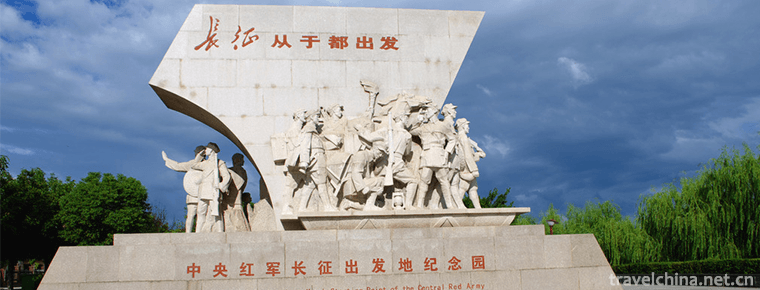
-
Jinli Street
Address:No. 231, Wuhou Temple street, Chengdu, Sichuan,China.
Views: 133 Time 2018-09-29 -
The Chongsheng Temple And The ThreePagoda
The Three Pagodas of Chongsheng Temple are situated 1.5 kilometers northwest of Dali ancient city.
Views: 172 Time 2018-10-17 -
Wa Palace Scenic Area Handan City
Wa Palace, located in Zhonghuangshan Mountain, Shexian County, Handan City, Hebei Province, covers an area of 5 square kilometers..
Views: 239 Time 2018-11-24 -
Qingjiang Gallery Scenic Area
Qingjiang Gallery Scenic Area, National AAAAA Class Tourist Area, National Geopark, National Forest Park, Ten New Brands of National Cultural Tourism, Ten Best Scenic Areas in Hubei Province, and Hube.
Views: 139 Time 2018-12-12 -
Donglin Temple
Donglin Temple, located at the foot of Lushan Mountain, Jiujiang City, Jiangxi Province, is 16 kilometers north of Jiujiang City and 50 kilometers east of Lushan Luling Street. Because it is east of X.
Views: 124 Time 2018-12-20 -
Lao Leshan Tourist Scenic Spot
Lao Leshan is located in the south of Henan Province, 9 kilometers southwest of Zhumadian City and 8 kilometers west of Queshan County. National Highway 107.
Views: 136 Time 2019-01-29 -
Wuhou Tomb Scenic Area
The Tomb of Marquis Wu is the tomb of Zhuge Liang, a famous statesman and militarist in the Three Kingdoms Period. It is located at the foot of the ancient battlefield of Dingjunshan.
Views: 147 Time 2019-02-24 -
Winter capture of Chagan Lake
Winter fishing in Chagan Lake, namely ice and snow fishing (or hunting) in Chagan Lake in winter, is a traditional fishery production mode (custom) in Qianguoerros Mongolian Autonomous County.
Views: 167 Time 2019-04-15 -
Guan Suo Opera
Guansuo Opera is a kind of local opera, which belongs to the ancient Nuo Opera. It is only found in Xiaotun Village, Yangzong Town, Chengjiang County, Yunnan Province. .
Views: 160 Time 2019-05-01 -
Hu Ji Shu Hui
Hu Jishu Fair is a traditional folk art fair that rose and took root in Huji Town, Huimin County, Shandong Province. Huji is the largest market town in the southeast of Huimin County.
Views: 97 Time 2019-05-03 -
Puppet Head Sculpture
Zhangzhou puppet head carving is a traditional folk arts and crafts in Zhangzhou City, Fujian Province. It belongs to a special skill in the production of puppet stage props. Zhangzhou puppet head car.
Views: 103 Time 2019-06-06 -
Neijiang climate
Neijiang City belongs to subtropical humid monsoon climate. Affected by the basin and the natural environment, it has the characteristics of mild climate, abundant rainfall, sufficient light and heat, and long frost free period. It is warm in winter and hot in summer,.
Views: 295 Time 2020-12-16
